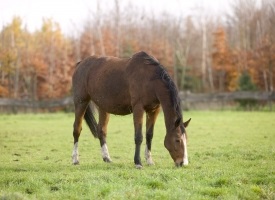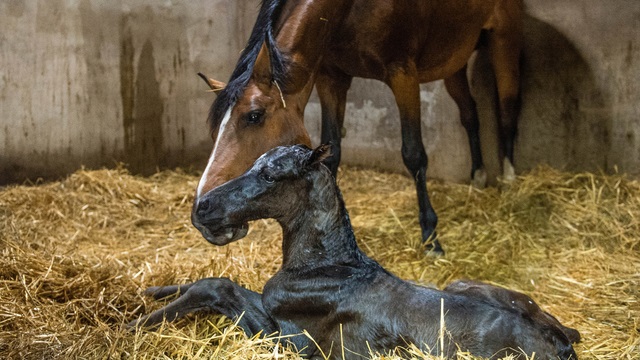Feeding and breeding

Pregnant mare: nutrition and labor
For every breeder, spring is an exciting, but also anxious time. In the run-up to the birth, it is good to think about the feeding requirements of the mare before but also after the foal is born, when the mare is fully in lactation. And what about actually riding a pregnant mare?
Fertility and the mare
Typically, a mare will start her cycles in early spring and will be in heat every three weeks up till September. The fertile period of the mare lasts 3 to 7 days. If the mare is in a poor condition (too thin), fertility problems can arise. Besides ensuring regularity in daily life, a decent stable hygiene, sufficient movement and a stress-free environment, the following vitamins and minerals can also have a positive effect on the mare’s fertility:
Beta-carotene (or pro-vitamin A): Beta-carotene supports the start of the cycle early in the season, the mare will be in a better heat, it also decreases the risk of early embryonic death.
Vitamin E: A deficiency of vitamin E will result in infertility. In pregnant mares, the deficiency will result in deformation of the foal (white muscle disease) or abortion.
Folic acid: Folic acid is known for its positive effects on pregnant women, however little is known about the effects on pregnant mares.
Selenium: Has a similar effect on fertility as vitamin E.
The feed supplement Pavo Fertile contains, among other things, the abovementioned substances and can therefore support the fertility of the mare.
Gestating or lactating mare and roughage
Grass in springtime contains the ideal nutrients for mares, however, dried forage often contains far less proteins and minerals than people think. It also contains much less vitamin E compared to fresh grass. Forage from poor nutritional quality is sufficient for fat horses and coldbreds, but not for a pregnant/lactating mare. Many mares only have access to grass later in the season and do not always have access to sufficient grassland to meet their requirements. Feeding only dried forage is not sufficient and can cause a vitamin E deficiency, which in turn increases the risk that the placenta will Not come off.
Feeding the mare in gestation
During the first eight months of gestation, the mare’s regular diet will be sufficient, but during the last three months of gestation, the mare’s nutritional needs change enormously. During those last three months, the unborn foal in the experiences a major growth spurt. The nutrients needed for this growth are passed on to the foal in the uterus via the blood and after the birth through the mare’s milk. Deficiencies in certain nutrients may result in a disposition to bone disorders such as OC or OCD. Pavo Podo®Lac and Pavo Podo®Lac Muesli are developed especially for mares in foal and lactating mares and contains all the vitamins, minerals and trace elements that are necessary for an optimum development and growth of the (unborn) foal.
Feeding during lactation
After birth, the mare’s energy and protein requirements increase enormously. In the first days, a mare produces approximately eight liters milk per day, which gradually increases to twenty liters. A shortage in proteins is detrimental and will cause a reduced milk production and muscle mass reduction in the mare. In lactating mares, the energy and protein requirements are twice as high compared to a mare without a foal. During the first three months of lactation, you can continue to give your mare Pavo Podo®Lac or Pavo Podo®Lac Muesli. When the foal is about three weeks old, it will start to eat concentrates and therefore, the ration of the mare can gradually be decreased. As soon as the foal has been weaned, the mare can go back to her normal diet.
Put fat gestating mares on a diet?
A mare should not be too fat during her pregnancy. The reason is that foals of fat mares grow faster which is not beneficial for the quality of the bones. However, it is not wise to put the mare on a diet after the ninth month of gestation, as the foal is then going through the largest development. You can make sure that she does not becomes fatter and still got all the nutrients she needs, by using the breeding balancer Pavo Podo®Care instead of mare compound feed. Besides, more natural movement and some exercise (adapted to her condition) may help.
Riding a gestating mare
If the mare has no medical conditions that may increase the risk for complications during gestation or giving birth, you can continue exercising the mare as usual. Only in the last months of the gestation, the mare might get too heavy and/or her stamina and flexibility might decrease, which means you will have to adjust the intensity of your training schedule. Most importantly, you have to keep a close eye on your mare and use the signals that she gives to decide what she can still do. On the other hand, you should not all of a sudden stop exercising her, as it is indeed very healthy to exercise a mare until the last days. However, do not ride your mare in the last weeks, but give her some unloaded movement. After all, a good physical condition is a prerogative for an easy foaling process.
Feeding and breeding

Foal coming: everything you need to know!
What could be more delightful than a mare and her foal in the pasture? The parturition is
approaching, which is an exciting moment! But how do you know the foal is coming? And
what is important during and right after the parturition?
Pre-parturition
Not all pregnant mares with foal will show identical signs that the foaling is imminent. Typically, when the udder becomes really full, the muscles on either side of the base of the tail will begin to relax, showing as hollow areas on either side of the top of the tail , and wax-like beads appear on the end of each teat, the birth of the foal may only be a few hours away. Make sure that you are optimally
prepared for the parturition by having the following items ready or arranged:
Towards the end of the gestation, have a birth alarm system ready for use
Install a webcam, so you can also check on your mare from home
Make sure to have a big box clean and ready for foaling, with a thick straw bedding, so that the mare can lay down comfortably. When you do not have a big box available, a safe paddock may be an alternative
Ensure there is enough light in the stable (leave a light on also during the night)
Write down useful phone numbers, such as your vet’s phone number, or from someone who can possibly transport the mare and/or foal to a clinic, if necessary
Make sure you have some frozen colostrum, or a Pavo SOS-kit, just in case something goes wrong with the mare, or if the foal refuses to drink
Put a bandage on your mare’s tail, so you have a clear vision of the entire process
You also need to prepare: towels, a clean bucket, Povidone iodine and iodopovidone shampoo, an umbilical cord clamp and a pair of scissors.
During the parturition
When the mare starts to give birth and the amniotic sac is visible, check if the foal’s position is correct. Check if you can feel the two front legs and the head. If this is not the case, then the foal might be in a wrong position. Make your mare stand up and call the vet immediately.
The first 24 hours after parturition
The first 24 hours in the life of a foal are crucial. It is important that you check a number of issues (see table 1 below). Right after birth, the foal is completely dependent on the antibodies in the first mare’s milk, also called colostrum, for protection against diseases. Only during the first 24 hours, the
antibodies from the colostrum can pass through the foal’s intestinal wall and be absorbed in the
bloodstream. When the foal refuses to drink when the mare suffers from mastitis or has passed away,
then frozen colostrum or the Pavo SOS-kit containing artificial colostrum can provide a solution.
Table 1: What happens with a healthy foal?
A healthy foal:
Within
Stands
< 1 – 2 hours
Nurses
< 2 – 4 hours
Urinates
< 8 hours
Intake of moisture
< 12 hours
Pass the meconium
< 12 – 24 hours
An orphan foal
It is the nightmare of every breeder: problems during the birth process. It is important that you know
what to do and who to contact when problems occur.
Check beforehand if there are any Facebook groups or pages for foster mares and orphan foals.
Should the mare or the foal not survive the birthing, than check these pages. Through this page, you
can try to arrange an adoption. In case you need a surrogate mare that has lost her foal, check what
the cause was. If a disease is suspected, it is better not to place the foal at this mare. Make good
arrangements with the other arty prior to the placement and put these on paper. There are
accommodations where several orphaned foals are placed together.
Another solution could be a foster mare that did not give birth to a foal, but will lactate after a special
treatment. Usually, in this situation, the orphan foal is accepted more easily. During the foal
season, some vet clinics, have foster mares available that can be taken home with the foal from the
moment of adoption to the moment of weaning, allowing the foal to be raised in its own environment.
Weaning the foal
Most foals are being weaned between five and six months of age, when it eats roughage and a foal
balancer/concentrates independently. To gradually reduce the milk production in the mare, it is
recommended to reduce the quantity of her concentrates by half. Three days before the planned
weaning, the concentrate feed can be stopped completely . Ensure the mare gets sufficient natural
movement.
Deworming the foal
It is advisable to deworm the foal between day four and day eight. This should then be repeated after
four to six weeks. After that, in consultation with your vet, a normal deworming program can be
maintained. Note: the deworming paste should be appropriate for foals.